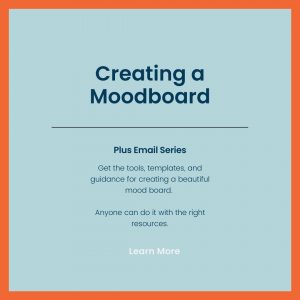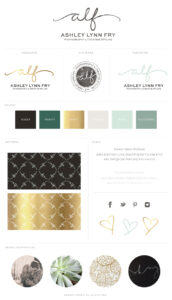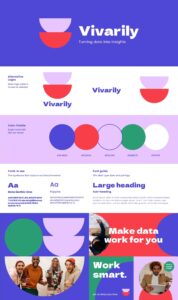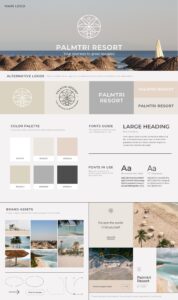Creating a Mood Board for Your Company + Free Mini Course

Mood boards are a popular tool that anyone ranging from interior designers to marketers to fashion brands uses. It’s common for color swatches or trendy descriptors to come to mind when someone mentions a mood board. But what actually goes on a mood board encompasses much more.
What exactly is a mood board?
Simply put, a mood board is a visual collection of ideas that contains images, text, color palettes, videos, etc. The board can be physical or digital, depending on your preference.
The fact that it’s a visual representation of an idea, theme, or concept is important, given that more than half of the human population identifies as visual learners.



What’s the purpose of a mood board?
There are a few different functions that mood boards have, depending on where you’re at in your development stage, or what exactly you’re looking to create. ( i.e. branding, new product, marketing campaign, etc.)
Brainstorming
A mood board is a great way to explore different directions or perspectives for your idea. You may find yourself using images or a font that you originally didn’t think about. Having space and tools at your disposal to experiment may help you think outside of the box or dig deeper.
2. Communication
Once you feel like you’ve got a handle on the concept you’re exploring in your mood board, sharing it with your team helps everyone get on the same page. It bridges gaps in understanding and gives people a tangible representation to refer to. (Sometimes it’s easier to show “a feeling” versus explaining it.)
3. Reference Point
After you and your team share an understanding of the mood board and what it means, it shouldn’t just collect dust in your closet or in a random desktop file. It can serve as a compass to keep your development on track.
Tools to get started
In reality, there are far more resources out there than just the ones we’ve listed below. The following are some tried-and-true websites we go to for all kinds of inspiration, and some websites specifically designed for mood board creation.
Where to find inspiration?
- Instagram: search ‘mood board’ and feast your eyes on the results.
- Pinterest: this is a multi-functional site in that you can find examples, as well as download templates from pins, or simply create a new Pinterest board and use it for your mood board.
- Google Images – another place to find examples or use a template
- Physical environment: once you’re in the “creative mindset”, I encourage you to go somewhere that may look like what you’re hoping to capture. (Downtown, beach coast, local pub, etc.) Walk around and see what inspires you. Take pictures or videos with your phone – things that strike you, intrigue you, or that you’d like to replicate.
Programs to try
- Canva: this free graphic design website has a ton of great resources, including premade templates and tools.
- Adobe Express: Adobe offers a free program that helps you create a mood board from customizable premade formats. This is good for someone who wants an easy-to-follow structure.
- Milanost: This is a really cool website designed for the brainstorming process/ early development stages. It’s free, versatile, and also offers additional guidance for getting started. This is perfect for someone who’s looking to dive into their mood board with reckless abandon.
Who do I share my mood board with?
The better question is, ‘Who don’t I share my mood board with?’ It’s true that your dentist may not need to see it, but consider the following:
- Web developer
- Photographer
- Graphic designer
- Social media manager
- Printshop
- Branding freelancer/agency
- Assistants
A process to consider
We’ve identified some stages for you to move through as you make your mood board. As with many aspects of the creative process, you’ll probably want to personalize it, which we absolutely encourage. Take what’s helpful, leave what isn’t.
Reflect on your intention for the mood board
- What are you creating your mood board for? Your brand? A new product?
- What’s the ‘feel’ you’re going for?
- Are you going to need more than one board for options?
Explore templates & programs
- How much structure are you wanting?
- How much time are you willing to invest?
Start collecting elements for your board
- Don’t get in your own way. Experiment, try different directions… Go nuts!
Refine
- Are the pieces on your board fitting into a coherent idea or theme?
- Do you feel like you need to adjust your original direction?
Feedback
- Reach out to your teammates or a trusted colleague for their thoughts
- Consider asking these types of questions:
- Do you see the concept I’m trying to communicate?
- Do you feel like you could use this board as a helpful guide?
The final stage
- Adjust your board as needed
- Share with your whole team or whoever’s working with you
- Keep it as the valuable guide that it is!
Creating your mood board is a creative process, which I’ll say right now, is not linear, structured, or perfect. So don’t try and make it that way.
Find your inner third grader and really let yourself explore and have fun. You can do this!
Wishing you had someone to walk you through this? We’ve got you.
Sign up for our “Mastering Mood Boards” email series below. We’ll break down the process into short daily activities so you can accomplish this creative tool with confidence. (We’ll give you some encouragement too). 😘